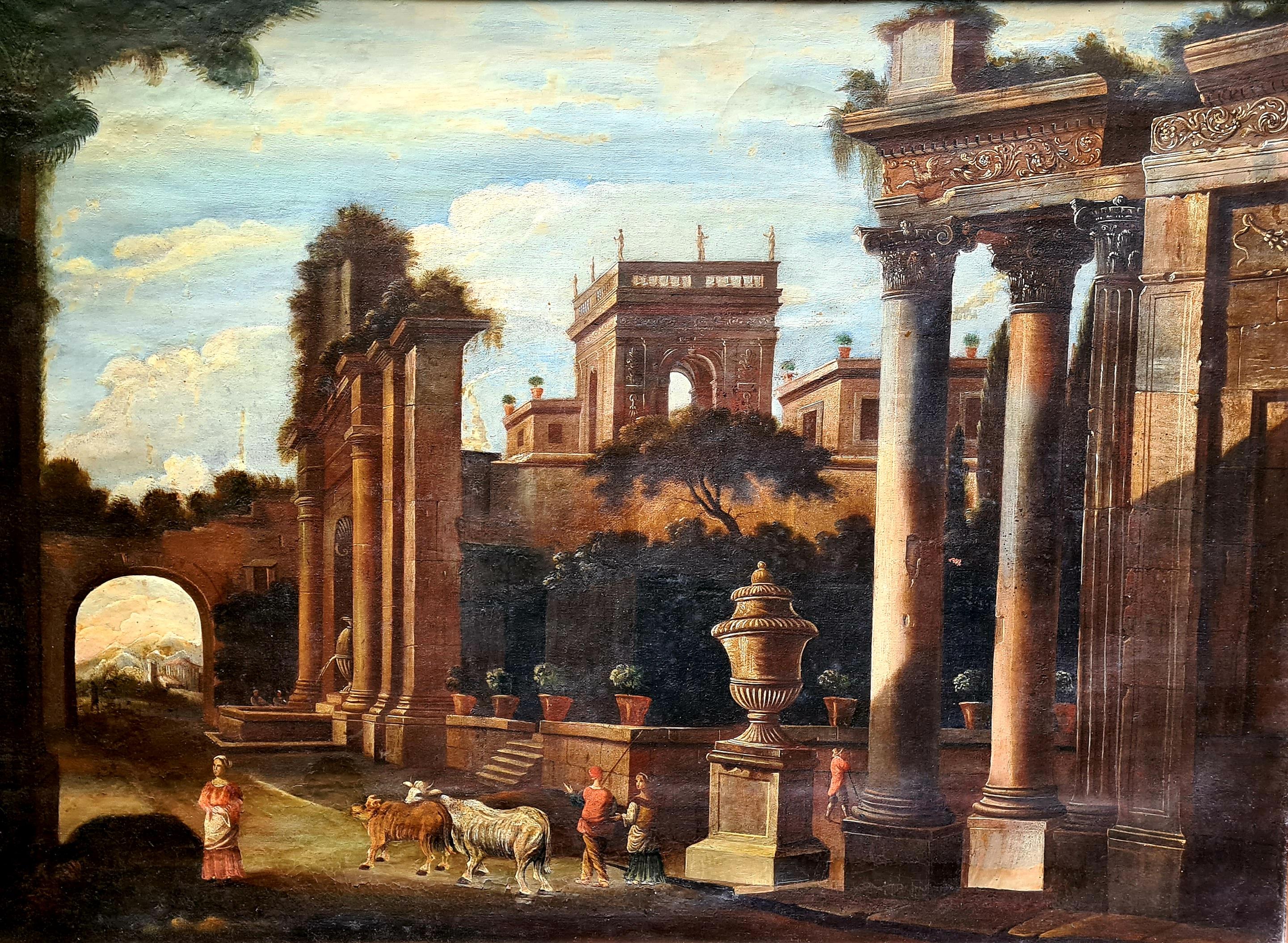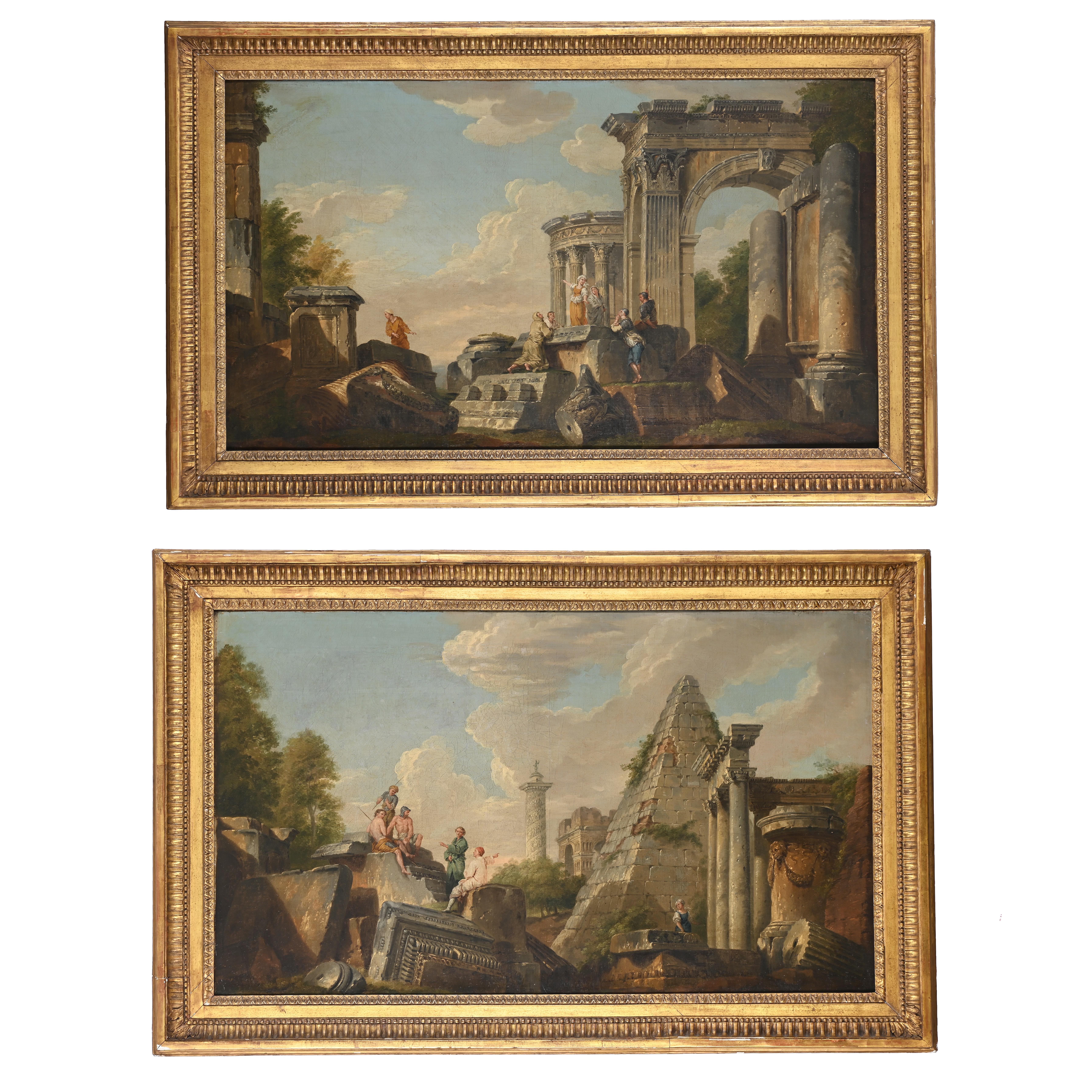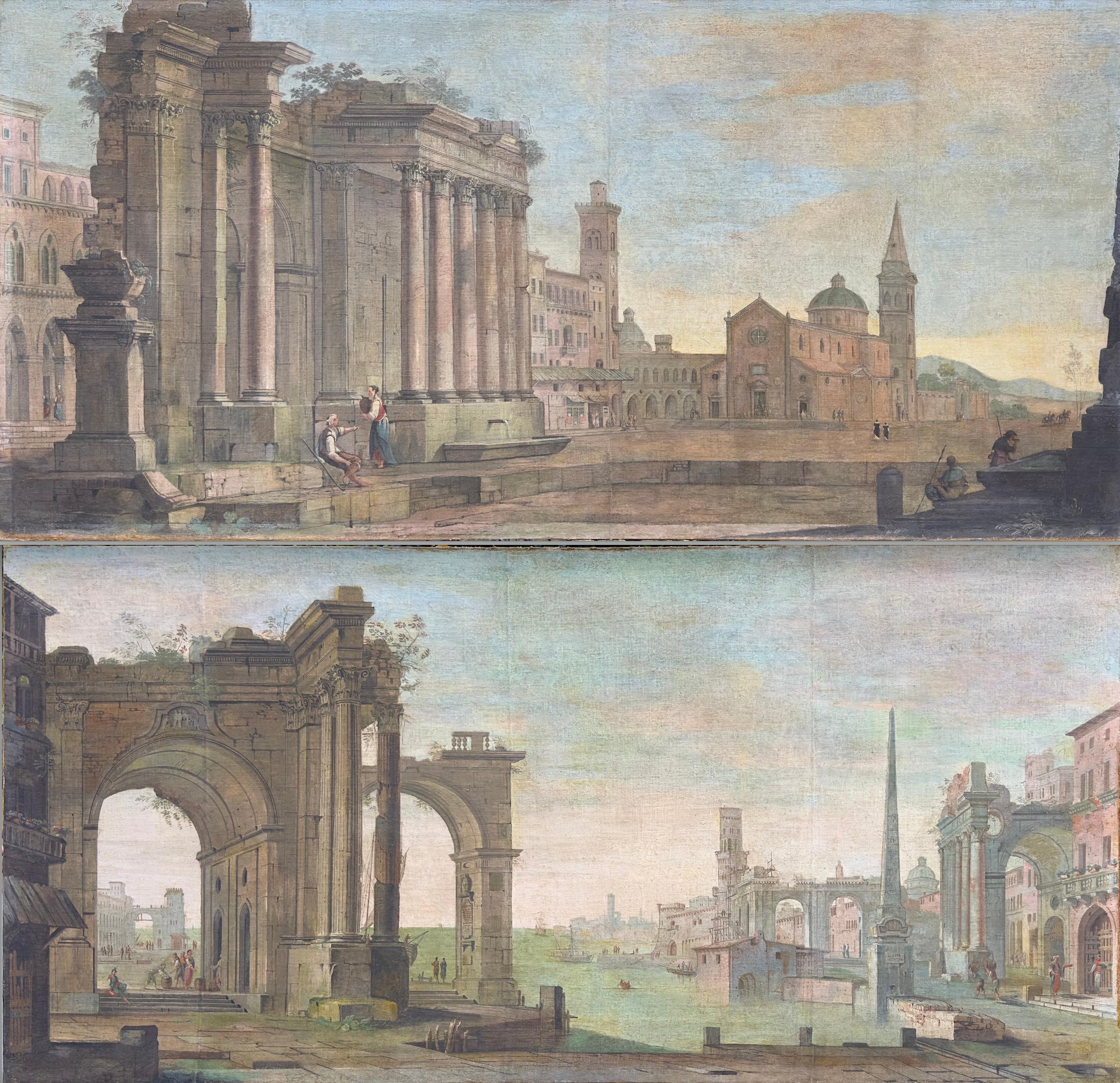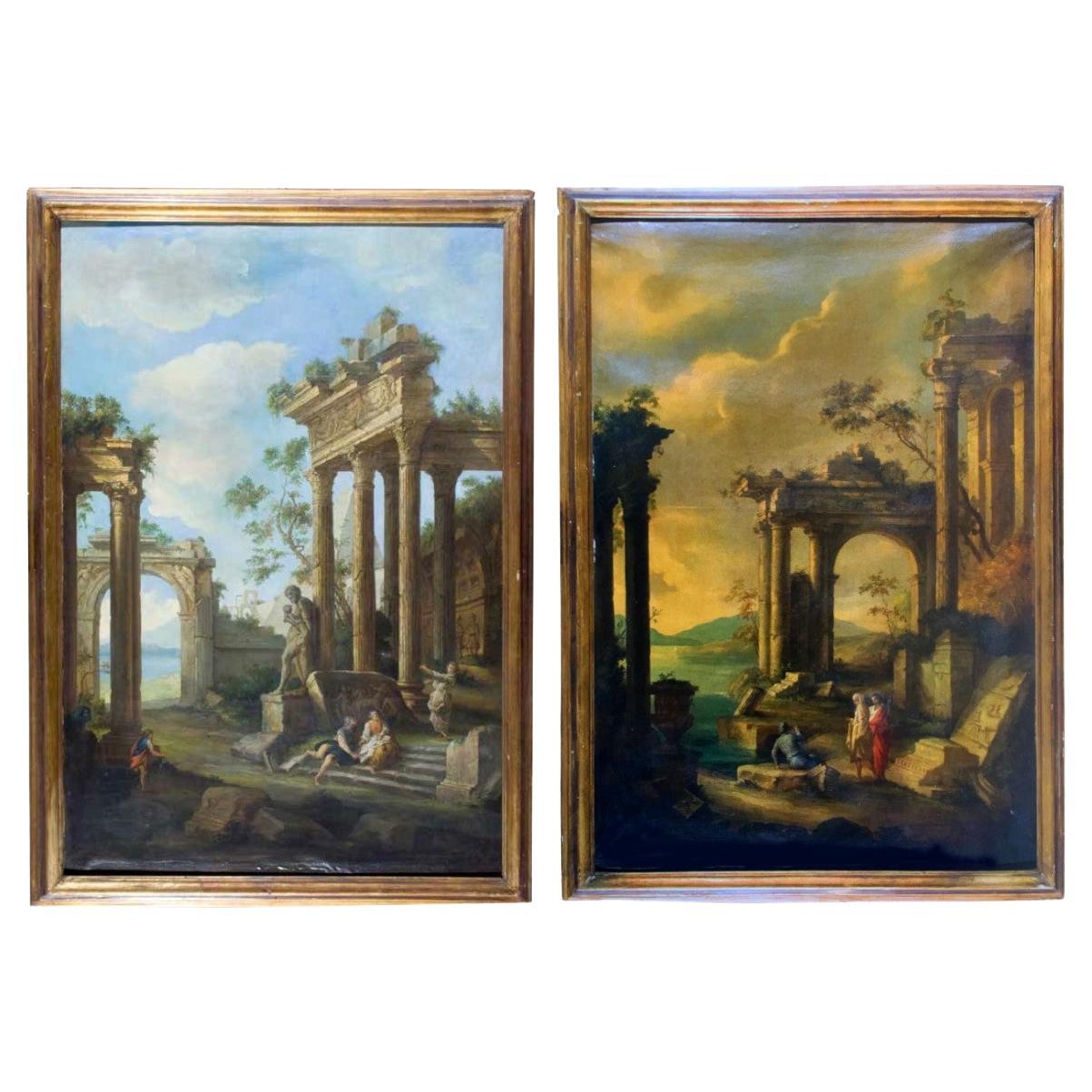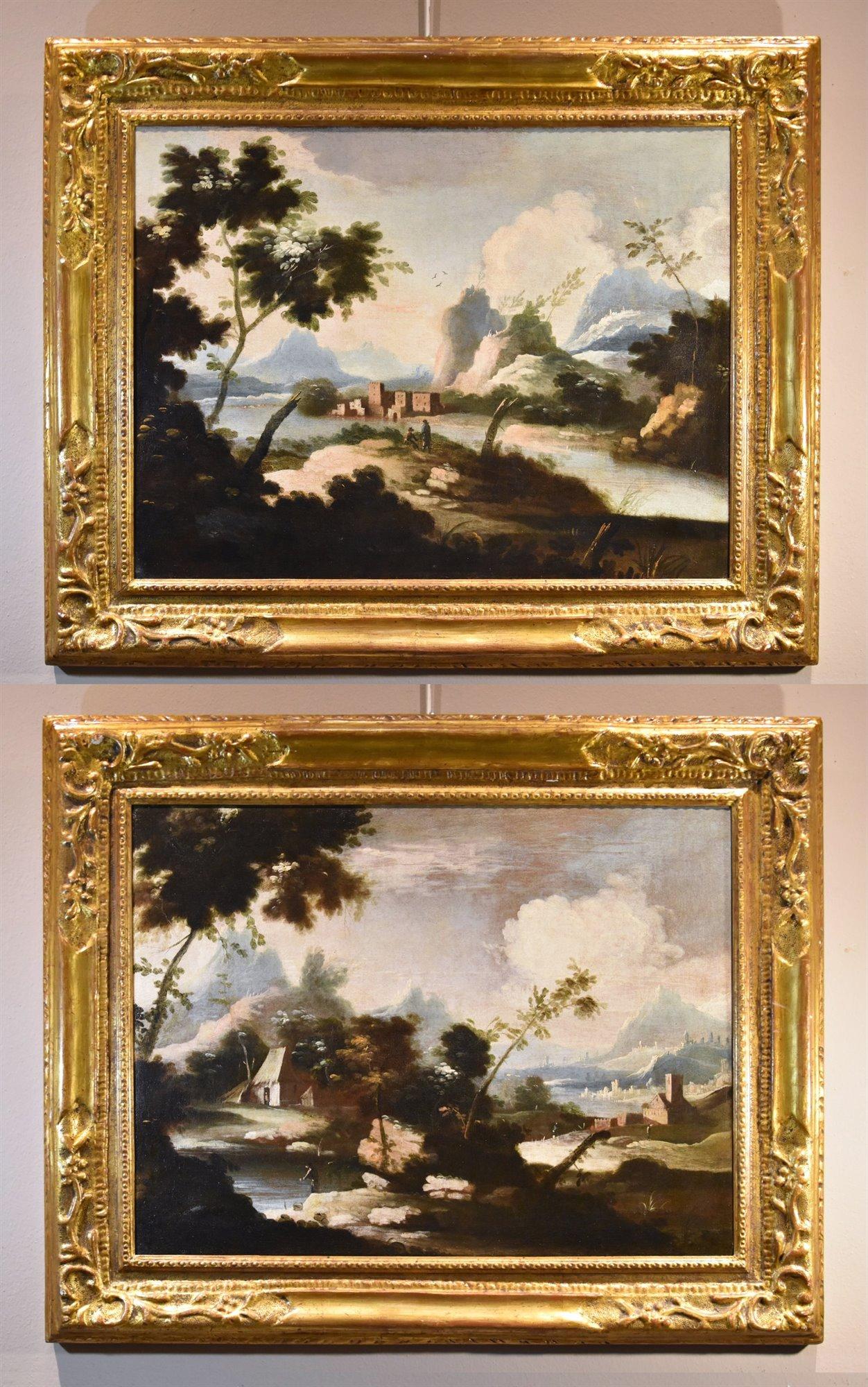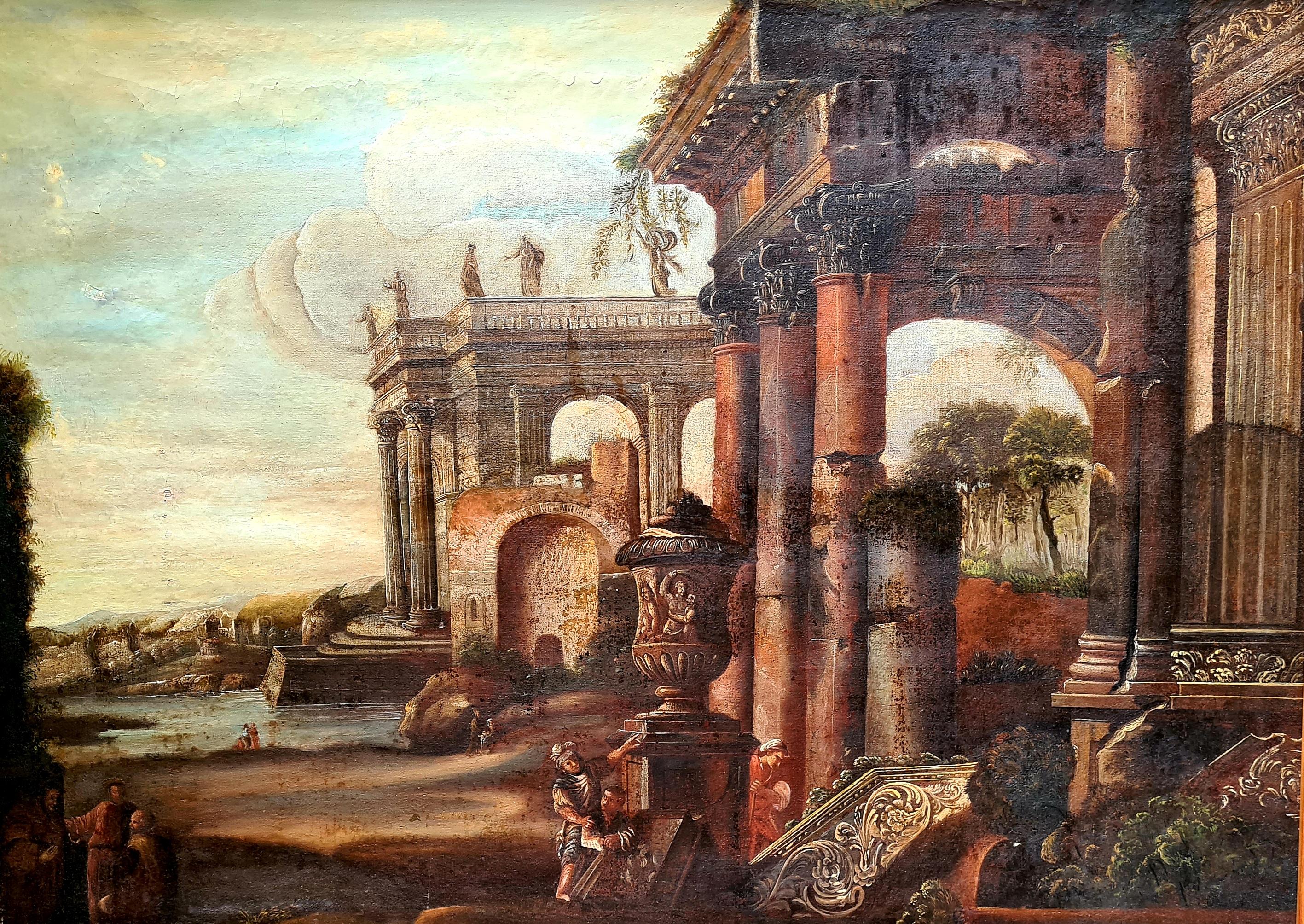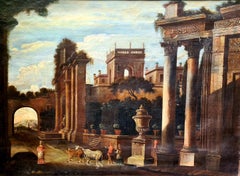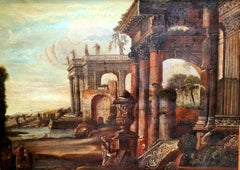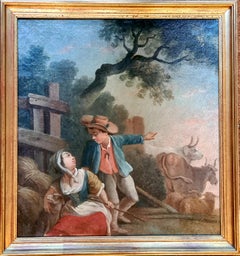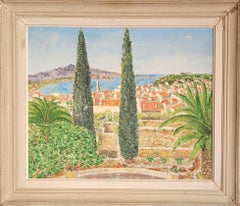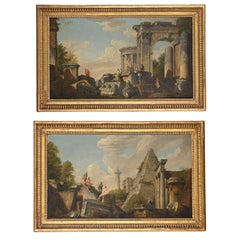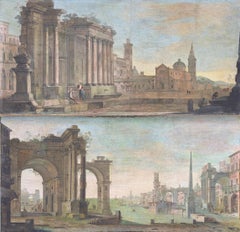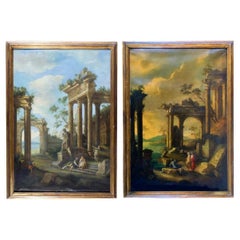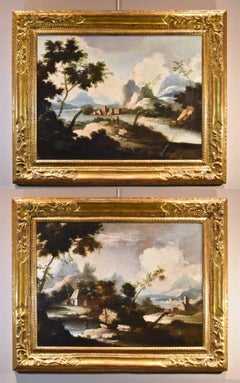Items Similar to Pair of Grand Tour 18th Century Veduta Capriccio Paintings, After Gennaro Greco
Video Loading
Want more images or videos?
Request additional images or videos from the seller
1 of 24
Pair of Grand Tour 18th Century Veduta Capriccio Paintings, After Gennaro Greco
$21,285.67
£16,180.67
€18,000
CA$29,913.82
A$32,527.02
CHF 17,138.56
MX$395,108.92
NOK 215,466.36
SEK 201,982.31
DKK 137,775.78
About the Item
A large pair of 18th century veduta capriccio scenes with temple ruins after Gennaro Greco from the circle of Pietro Cappelli. The paintings are presented in more modern carved gilt wood frames. Please see individual listings LU1430214555712 and LU1430214555672 for further photos and individual videos.
Provenance: An English collection and thence by descent.
These large eighteenth-century Italian oil on canvas paintings are a fine example of architectural fantasy. They are a work of excellent quality. Although the decorations of ancient buildings and sculptures are imaginary, they are designed to charm rather than describe. The ruins are animated by colourful characters. The artist's ability to use perspective and the skillful rendering of building materials, such as the realistic marbles of the columns, make these paintings a tour de force.
They are a magnificent large scale pair of veduta capriccio scenes with temple ruins, animals and figures socialising. Fantastic detail of statuary, idealised landscapes, costumes and of course the buildings themselves. Very much in the 'Grand Tour' style these are fantastic works that would have graced an important collection and would be a valuable and imposing addition to any interior or collection.
Gennaro Greco also known as "Il Mascacotta" (1663–1714) was an Italian architectural painter who was active in Naples during the late Baroque period. He is known for his architectural paintings, capricci, compositions with ruins, as well as his vedute. His vedute fall mostly in the category of the so-called vedute ideate which represent closely observed views of completely imaginary landscapes.
Pietro Capelli trained under Francesco Solimena and worked in his native Naples in the early 18th century. Mainly a painter of quadrature, he also painted landscapes. Capriccio scenes such as these, which combined architecture with landscape and genre figures, often required artists to collaborate according to their specialties, the figures and animals in this pair of scenes may have been completed by a different hand to the architectural ruins.
Pietro Capelli or Pietro Cappelli (born circa 1700, died 1724 or 1727[ was an Italian painter of the Rococo, active in his native city of Naples. He trained under Francesco Solimena. He was active in quadratura, but also painted capricci and canvases with landscapes.
He was a rival of Leonardo Coccorante. His father, Giuseppe Capelli, was a scenic designer at the Teatro San Bartolomeo in Naples. His brother, Giuseppe Cappelli (or Capelli) was a painter in Rome of scenographic decoration (theatrical decorations). Grossi states that he was so full of imagination, and fast at painting, that he did not even sketch beforehand for his works.
In painting, a capriccio is an architectural fantasy, placing together buildings, archaeological ruins and other architectural elements in fictional and often fantastical combinations. These paintings may also include staffage (figures). This style of painting was introduced in the Renaissance and continued into the Baroque.
By the late 18th century the term had expanded to mean any image with an equivalent degree of fantasy, for example as used in the titles of print series by Giovanni Battista Tiepolo and Goya, both of whom focus on figures rather than architecture.
- Dimensions:Height: 35.44 in (90 cm)Width: 45.67 in (116 cm)Depth: 3.55 in (9 cm)
- Medium:
- Movement & Style:
- Circle Of:Pietro Cappelli (1700 - 1724, Italian)
- Period:
- Condition:Extensive areas of old restoration. These paintings were restored and relined at the beginning of the 20th Century and it is from this time that the frames date. Some wear and losses to the frames.
- Gallery Location:Cotignac, FR
- Reference Number:Seller: LG/CappelliPair1stDibs: LU1430214395802
About the Seller
5.0
Platinum Seller
Premium sellers with a 4.7+ rating and 24-hour response times
Established in 2000
1stDibs seller since 2020
278 sales on 1stDibs
Typical response time: 1 hour
- ShippingRetrieving quote...Shipping from: Cotignac, France
- Return Policy
Authenticity Guarantee
In the unlikely event there’s an issue with an item’s authenticity, contact us within 1 year for a full refund. DetailsMoney-Back Guarantee
If your item is not as described, is damaged in transit, or does not arrive, contact us within 7 days for a full refund. Details24-Hour Cancellation
You have a 24-hour grace period in which to reconsider your purchase, with no questions asked.Vetted Professional Sellers
Our world-class sellers must adhere to strict standards for service and quality, maintaining the integrity of our listings.Price-Match Guarantee
If you find that a seller listed the same item for a lower price elsewhere, we’ll match it.Trusted Global Delivery
Our best-in-class carrier network provides specialized shipping options worldwide, including custom delivery.More From This Seller
View AllGrand Tour 18th Century Veduta Capriccio Painting, After Gennaro Greco
Located in Cotignac, FR
A fine, large 18th century veduta capriccio scene with temple ruins after Gennaro Greco from the circle of Pietro Cappelli. The painting is presented in a more modern carved gilt woo...
Category
18th Century Baroque Landscape Paintings
Materials
Oil, Canvas
$8,941 Sale Price
20% Off
Large Grand Tour 18th Century Capriccio Painting Roman Ruins after Gennaro Greco
Located in Cotignac, FR
A fine, large 18th century veduta capriccio scene with temple ruins after Gennaro Greco from the circle of Pietro Cappelli. The painting is presented in a more modern carved gilt woo...
Category
18th Century Baroque Landscape Paintings
Materials
Oil, Canvas
$8,987 Sale Price
20% Off
Rococo Pastoral Landscape, Figures, Oxen and Sheep Circle of Saverio Della Gatta
Located in Cotignac, FR
Late 18th or early 19th century oil on canvas Rococo idylic pastoral scene. Though not signed the painting is of very fine quality and is presented in a plain gilt wood frame.
This...
Category
18th Century Rococo Figurative Paintings
Materials
Canvas, Oil
The Côte d'Azur. Mid-Century Oil Landscape Painting.
Located in Cotignac, FR
Mid-century oil on board of a Mediterranean coastal scene by Janoti. Signed bottom right.
This artwork beautifully captures a sunlit Mediterranean landscape, dominated by the bold v...
Category
Mid-20th Century Landscape Paintings
Materials
Oil, Board
Piranesi, Hand Coloured Period Engraving, Vue d'un Superb Palais de Rome
By Giovanni Battista Piranesi
Located in Cotignac, FR
A fine hand coloured 18th Century engraving after the original by Piranesi (Rome 1743), published by Danisy, Paris. Presented in period gold leaf frame, under glass.
Piranesi was born in Venice, in the parish of S. Moisè where he was baptised. His father was a stonemason. His brother Andrea introduced him to Latin literature and ancient Greco-Roman civilization, and later he was apprenticed under his uncle, Matteo Lucchesi, who was a leading architect in Magistrato delle Acque, the state organization responsible for engineering and restoring historical buildings.
From 1740, he had an opportunity to work in Rome as a draughtsman for Marco Foscarini, the Venetian ambassador of the new Pope Benedict XIV. He resided in the Palazzo Venezia and studied under Giuseppe Vasi, who introduced him to the art of etching and engraving of the city and its monuments. Giuseppe Vasi found Piranesi's talent was much greater than that of a mere engraver. According to Legrand, Vasi told Piranesi that "you are too much of a painter, my friend, to be an engraver."
After his studies with Vasi, he collaborated with pupils of the French Academy in Rome to produce a series of vedute (views) of the city; his first work was Prima parte di Architettura e Prospettive (1743), followed in 1745 by Varie Vedute di Roma Antica e Moderna.
From 1743 to 1747, he was mainly in Venice where, according to some sources, he often visited Giovanni Battista Tiepolo, a leading artist in Venice. It was Tiepolo who expanded the restrictive conventions of reproductive, topographical and antiquarian engravings. He then returned to Rome, where he opened a workshop in Via del Corso. In 1748–1774, he created an important series of vedute of the city which established his fame. In the meantime Piranesi devoted himself to the measurement of many of the ancient buildings: this led to the publication of Le Antichità Romane de' tempo della prima Repubblica e dei primi imperatori ("Roman Antiquities of the Time of the First Republic...
Category
Late 18th Century Baroque Landscape Prints
Materials
Paper, Watercolor, Ink
Pair of French Mid Century Drawings, 'Ligne Claire' after Hergé, Grasse and Nice
Located in Cotignac, FR
Pair of French mid 20th Century drawing in the style of Georges Remi, dit Hergé. The works are not signed but both are titled and dated. Presented in modern frames under glass.
The first is a charming street view of Cannes on the Cote D'Azur in the south of France, an area now internationally famous for its annual film festival. The artist has captured the imposing nature of the fine stone buildings with their blue and green shutters towering over the scene. Next to it fine trees so characteristic of French streets are just coming in to leaf. Two men go about their business, one is walking towards a cafe. Cars and a red delivery truck animate the scene.
The second an equally charming view of the chapel at the Nice Chateau cemetery on the Cote D'Azur in the south of France. The artist has captured the imposing nature of the fine colourful stone buildings with their arches, cupolas and finials. Surrounding the buildings are trees and bushes and to the foreground cars of typical 1960s design. The style of the artist is clearly inspired by the animations of Georges Remi, dit Hergé which were so popular at this period.
Georges Remi, more commonly known as Hergé created his own clean, expressive style of drawings known as ligne claire...
Category
Mid-20th Century Modern Landscape Paintings
Materials
Crayon
You May Also Like
A pair of 18th century Italian landscapes with classical ruins and figures
By Giovanni Paolo Panini
Located in Bath, Somerset
A pair of 18th century Italian landscapes with classical ruins and figures, circa 1750.
Circle of Giovanni Panini (1691-1765)
Thomas Agnew and Sons, Lo...
Category
18th Century Old Masters Landscape Paintings
Materials
Canvas, Oil
Pair of Italian 18th Century Tempera on Canvas Classical Paintings "Capriccio"
By Pietro Paltronieri
Located in Rome, IT
A fine pair of huge Italian 18' century Capriccio with Classical ruins, tempera oil on canvas .
Atr.Pietro Paltronieri, il Mirandolese (Mirandola 1673-1741 Bologna).
Measurements ...
Category
Mid-18th Century Old Masters Landscape Paintings
Materials
Tempera
Italian Painter of 1700 "Capriccio with classical ruins and figures"
Located in Cesena, FC
Painter of ruins xviii century:
"capriccio with classical ruins and four figures" , pendant with "capriccio with classical ruins and three figures"
Oil on canvas cm 140 x 95
The ...
Category
Antique 1730s Italian Paintings
Materials
Canvas
Landscapes Couple Ricci Paint 18th Century Oil on canvas Old master Italy
Located in Riva del Garda, IT
Marco Ricci (Belluno 1676 – Venice 1730)
Circle of Pair of Arcadian landscapes with figures
Oil on canvas 56 x 72 cm. - Framed 77 x 93 cm.
This pair of charming landscapes, ex...
Category
18th Century Old Masters Paintings
Materials
Oil
$9,543 Sale Price
20% Off
Couple of Italian Paintings Depicting Capricci, Francesco Aviani ‘1662-1715’
Located in IT
Francesco Aviani (Italy - Venice, 25-11-1662 / 1715) att.
Couple of paintings depicting Capricci
Oil on canvas, 135 x 183 cm, without frame
The two large and fine paintings depict two illusionistic architectural renderings, with views of colonnades and arched buildings, animated by figures. The compositions are characterized by the harmony with which the painter introduces the sumptuous architectural monuments, the mirrors of water, the buildings in the distance and the views of the landscape. Dominates with a color on the tones of brown and ochre that stands out on the blue sky, marked by some cloud of steam. The insertion of the figures to enliven the architectural views also balances with the set.
The Capriccio, an artistic genre that has made its way into Italian painting since the 17th Century, is characterized by the representation of fantastic architectures or prospective inventions, sometimes combined with elements drawn freely from reality. The two paintings are an example of this type and they are a very interesting and Fine artwork.
The remarkable pictorial quality emerges both from the composition of the ensemble and from the way in which the artist describes the views with great attention to detail, highlights and refined, perfectly realistic, chiaroscuro.
The same must be recognized for the figures: these are described with a wise brushstroke, quick and quick touches give the dynamism of the moment that is captured, as if time had stopped to show and narrate what is happening.
The painting on the right represents a large Baroque building in stone and paved with marbles, two floors, with moving façade, large columns with corinthian columns, a large portal with a staircase with large footsteps, a balustrade with string, from which some figures appear, and two equestrian monuments in bronze. The sumptuous building overlooks a large POOL of water, with a gushing fountain, around which some characters sit. In the second floor is described a white palace from which rises a tower crowned by a structure with wrought iron loggia. In addition there is a bridge and some architectural ruins behind which some mountainous reliefs fade towards the horizon.
On the staircase is described a particular scene. The people seem to be part of a very precise story. A woman, in the shadow of a parasol supported by a servant, would seem to drive out of the palace a man, who, taken under his arm by two maidens with a determined attitude, is led to a boat.
The scene could be identified with the biblical episode of the parable of the prodigal son (Luke 15,11-32), at the moment when the prodigal son is robbed and driven away by the harlots.
The episode tells of a man with two children. The youngest said to his father: “Father, give me the part of my inheritance”. And the father divided the substances. After not many days, the youngest son, collected his things, left for a far country and there he lost his substances with prostitutes and living as a debaucher. When he had spent everything, there came a great famine in that country and he began to find himself in need. Reduced to hunger, he was forced to be a pig herder to survive. He therefore meditated in his heart to go to his father and ask for his forgiveness and to be welcomed anew, even as a servant.
While still on the road, however, the father saw him and ran towards him, receiving him with open arms. He then ordered his servants to prepare a great feast for the occasion, killing for the purpose the "fatty calf". The firstborn did not understand why his brother was given such treatment, and reminded the parent that he, who had always obeyed him, had never received a single kid to celebrate with his friends. The father answered him: «Son, you are always with me and everything that is mine is yours; but it was necessary to celebrate and rejoice, because this brother of yours was dead and came back to life, was lost and was found».
The parable of the prodigal son was often portrayed in painting and the scene he finds most is certainly that of returning home in his father’s arms. Among the many is a canvas by the famous painter Giovanni Paolo Pannini (or Panini) (Italy – Piacenza, 1691– Rome, 1765) kept at the Hallsborough Gallery in London.
Rather rare, however, is the scene of the prodigal son driven and robbed by harlots. There is an engraving by Hans Collaert II (1561-1620) in which this moment is described in the background compared to the moment, narratively later, in which he is penitent among the pigs.
The second painting, certainly pendant of the first, represents a similar palace, with some characters overlooking the balustrade marcapiano and other figures around the large bathtub quadrilobata. In the foreground is described a monument with two large stone sculptures. In the distance some architectural elements and, beyond, the mountains are lost on the horizon.
The studies related to the numerous painters of architectural views and caprices, active in Italy, and the archival documents found, which could better clarify commissions, biographies and certain works, are scarce and sporadic. Therefore there are still many difficulties in reconstructing a catalogue of autograph works for each author. Through paintings in private collections, in museums and paintings passed on the antique market it is however possible to advance some attributions in order to better delineate the various artistic figures.
The style of the works studied here leads to a dating that runs between the 17th and 18th Centuries, with obvious influences dictated by the perspectives of the brothers Galli Bibiena. The analysis of the architectures and the chromatic palette suggests that we are in the presence of a northern Italian and Venetian author. Observing the decorations and the volutes, the brightness and the perspective disposition in fact, we find several analogies with those used by the Vicenza painter Francesco Aviani, excellent in pictorial perspective and architectural views.
The biographical profile of Francesco Aviani (Italy - Vicenza, 1662-1715) was essentially traced in 1956 by Andreina Ballarin, then re-visited by Federica Spadotto in 2014 and Giancarlo Sestieri in 2015. Certain documents about his life are scarce, as are the documented works.
He was born in Venice, probably on 25 November 1662, to Bernardo and a Magdalene whose surname is unknown, and was baptized on 3 December 1662. Between 1701 and 1703 he worked, together with his brother MarCo, sculptor, for the fresco decoration (now illegible) of the church villa in Soella (Vicenza). On October 16, 1703 he married Isabella Carcano. On March 26, 1715 he made a will and died on April 3 of the same year, in Vicenza.
The frescoes in the refectory of the sanctuary of Monte Berico in Vicenza are considered authentic works by Aviani, probably made in 1708; the paintings preserved in the Civic Museum of Vicenza: “Landscape with Lazzaro and the rich Epulone”; “Christ among the doctors”; “The miraculous fishing”, works not datable but with attribution corroborated by style. In addition, the frescoes in the east and west corridors of the Villa La Rotonda, near Vicenza; the fresco in the apse basin of the chapel of the church S. Croce, Vicenza, now destroyed; the frescoes of the central hall of Villa Camerini a Montruglio (1714) and a painting of a “Porto Regio”, of which we have a print engraved by Dall'Acqua.
From his works emerges the artistic background that animated the Venetian culture in the early eighteenth century. The scenic grandeur with which Aviani treats the architecture also suggests a stay in Emilia of the painter, in which he could have come into contact with the environment of the Bibiena. These contacts would be confirmed by the press of Cristoforo Dall'Acqua (Vicenza 1734-1787), “Il porto regio”, after a painting of Aviani. The press was part of a group of engravings, representing royal buildings, reproducing paintings of the Bibiena. In the eyes of Dall’Acqua, therefore, Aviani’s work was not foreign among those of the Emilians.
Inside the sumptuous architectural whims, Aviani often depicts biblical scenes, in which the characters share the space and the narrative rhythm, along with figures drawn from everyday scenes, memories of the Veronese and Bassano heritage. Also in the works covered by this study the author does not seem to want to give up a biblical subject, though the purpose of the paintings appears to be clearly a staging scenography-architectural within which the characters are relegated to the role of extras.
From the examination of the architectural Capriccio gathered under the name of Aviani then emerge common elements. The comparison between these works and the works in question highlights the proximity of the compositions. The imposing and scenic architectures are in fact equally characterized by the perspective-scenographic ability diffused in emilian “quadraturisti” and in Bibiena work. In fact, you can see the spectacular slender architecture in the lower part, the loggias that create chiaroscuro games with arches and binate columns placed on massive bases and overhung by projecting cornices.
Significant also the comparison with two paintings with architectural whims in a night vision attributed to Francesco Aviani.
In Aviani’s works it is possible to find a certain knowledge of the Roman Codazzi paint nd its early development of the eighteenth century, developed with the Locatelli, the Pannini and the less known Domenico Roberti. To Roberti have been recently attributed two works that have some compositional affinity with the canvases in question. The same can be done for a work on the antique market, attributed to Pietro Francesco...
Category
Antique Late 17th Century Italian Baroque Paintings
Materials
Canvas
Pair of Italian 18' century Paintings with Gardens
Located in Rome, IT
Pair of Italian 18' century paintings , oil on canvas with Venetian Palace gardens , antiques sculptures and various figures .
Measurements with f...
Category
Mid-18th Century Old Masters Landscape Paintings
Materials
Oil
More Ways To Browse
18th Century Baroque Painting
18th Century Baroque Frame
Capriccio Painting
Oil Painting Capriccio
18th Century Capriccio
Grand Tour Oil Painting
Australian Oil Painting
City Skyline Art
Hawaiian Oil Paintings
Ile De La Cite
Lake Boat Painting
Maggy Clarysse
Midwest Landscape
New Mexico Landscape Painting
Notre Dame Paris Painting
Oil Country Scene
Oil Paintings Wales
Pacific Northwest Art
